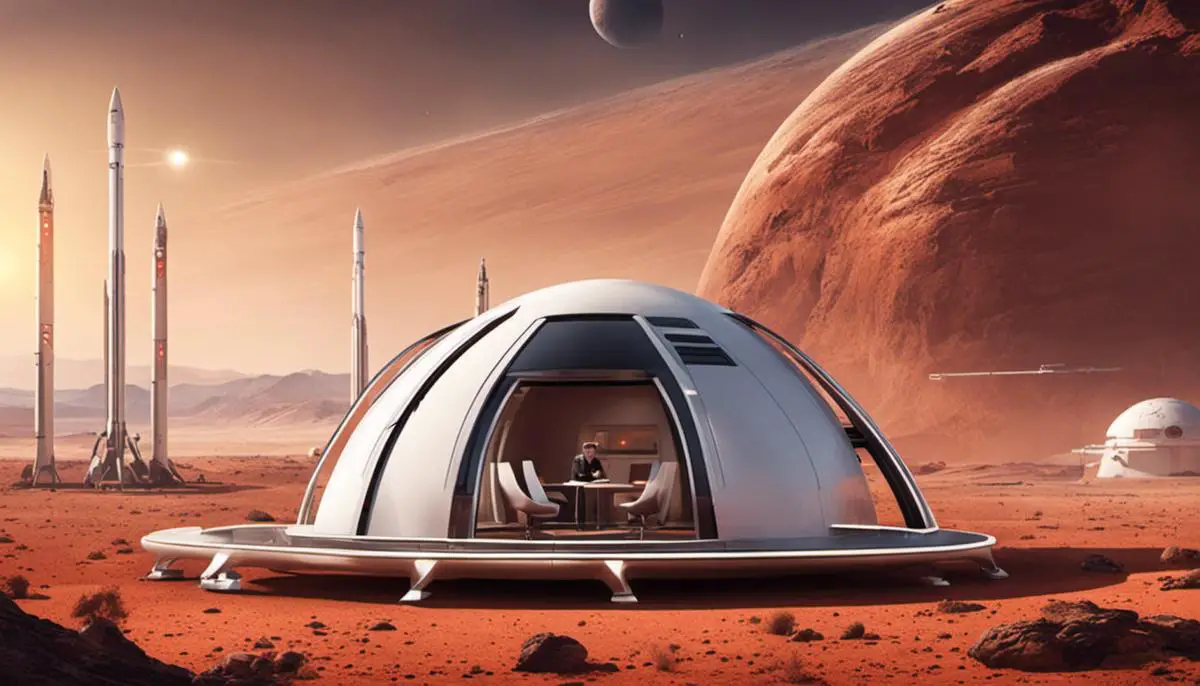Mankind has always been enchanted by the cosmos, fueling a desire for exploration and colonization beyond Earth. The forefront of this pursuit today is led by SpaceX, under the ambitious, visionary leadership of Elon Musk. With aspirations grand as transforming humanity into an interplanetary species and establishing a self-sustaining colony on Mars, SpaceX is changing the way we view our place in the universe. This narrative charts SpaceX’s progress thus far in Mars missions and examines the projected trajectory of their future endeavors. Equally crucial, it considers the associated challenges of colonization and the potential societal impact this bold agenda could have on our world.
SpaceX’s Vision for Mars
Elon Musk’s Vision for Mars Colonization
Elon Musk, the founder of SpaceX, has a grand vision for Mars colonization. He envisions humans becoming a multiplanetary species to ensure our long-term survival. Musk plans for a self-sustaining city on Mars with 1 million inhabitants by the year 2050. SpaceX aims to transform Mars into a livable environment for humans with water, oxygen, and essential resources.
Potential Habitability
Musk’s vision relies on the potential habitability of Mars. Mars has some critical elements that could support life with the right conditions. It possesses an atmosphere, albeit thin, and frozen water at its poles. The SpaceX Mars program would use technology to terraform the planet, making the climate more hospitable for human life. This would include warming the planet to unfreeze the water, which could be used for drinking and farming, and releasing the carbon dioxide beneath Mars’ surface to thicken the atmosphere.
Future Population on Mars
Musk’s plan entails sending 1 million people to Mars by 2050. Spacex would need to launch around three Starship flights per day to achieve this ambitious goal. Each Starship rocket would carry around 100 passengers. Multiple flights would increase the chance of survival should any mission fail, and an established population would make the Mars mission self-sustaining more quickly, a paramount factor for SpaceX.
Mars as a Backup for Earth
One significant reason Musk is driving the Mars mission is the idea of preserving the continuation of consciousness. Musk believes that Earth faces multiple existential risks, including but not restricted to natural disasters, nuclear wars, and diseases. Establishing a colony on Mars would serve as a “back-up drive” for human civilization, ensuring the survival of the species should Earth become uninhabitable.
Role of SpaceX’s Starship
The Starship, SpaceX’s under-development fully reusable spacecraft, plays a pivotal role in Musk’s Mars vision. Starship aims to be capable of transporting up to 100 people or 100 tons of cargo to Mars. SpaceX envisions a flotilla of 1,000 starships leaving Earth every 26 months, which is when the alignment of Earth and Mars offers the most efficient route.
Challenges & Pitfalls
While the ambition is commendable, many challenges lie ahead for SpaceX’s Mars Timeline. Besides technical and logistical difficulties, human health and ethical issues are also significant concerns that need to be addressed. Technologies for sustained life-support, food production, and radiation protection on Mars are yet to be fully developed. The sheer cost of the endeavor is also a major obstacle that SpaceX needs to overcome.
The Ultimate Objective
Elon Musk and SpaceX have a clear vision: colonizing Mars to secure humanity’s future in the vast expanse of space. This grand plan may seem like a plot out of a science fiction novel for many. However, considering the impressive strides SpaceX has been making, Musk’s long-cherished dream may not be far from reality.
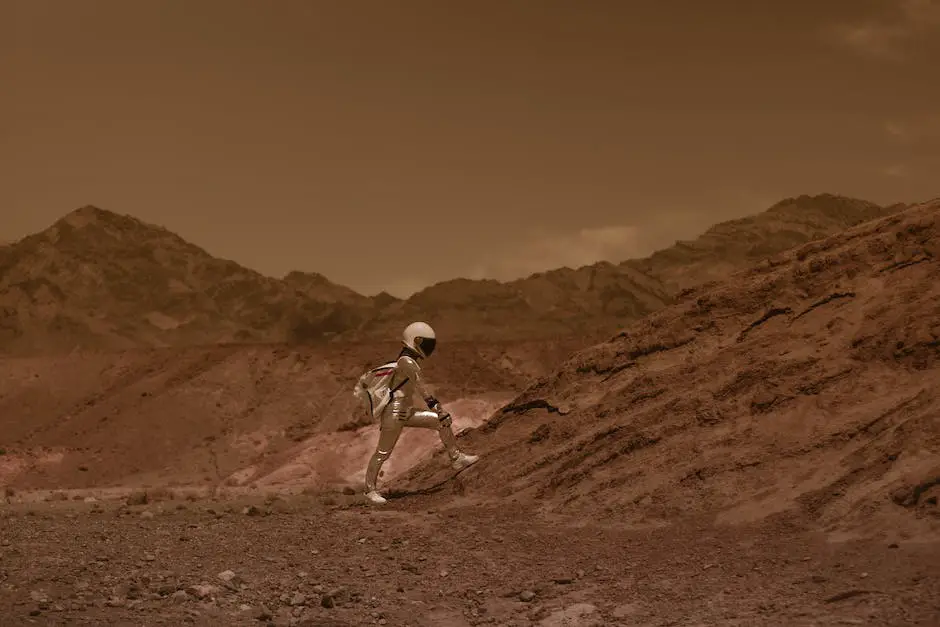
SpaceX’s Mars Missions: The Steps Taken so Far
From Humble Beginnings: Falcon 1 Through Falcon Heavy
The Mars mission of SpaceX traces its roots back to the development of Falcon 1, the company’s pioneer in orbital spacecraft. In 2006, it established a significant milestone by being the first privately-funded vessel to reach Earth’s orbit. A few years forward, the Falcon 9 outdid its predecessor by successfully delivering a commercial satellite to a geosynchronous orbit in 2013 — a first in space exploration history.
In a bold and symbolic gesture towards the Mars mission, the Falcon Heavy launched in 2018 carrying a unique payload – a red Tesla Roadster intended for a heliocentric orbit crossing Mars. While this served more as an ingenious marketing stunt than an actual Mars mission, it underscored the breathtaking potential of Falcon Heavy to propel substantial payloads deep into space.
Starship: The Vehicle for Mars
The spacecraft at the forefront of SpaceX’s Mars missions is Starship. Its prototype, Starhopper, successfully performed low-altitude test flights in 2019. Two subsequent iterations of Starhsip, SN5 and SN6, successfully completed similar hops in 2020.
The full-scale prototype SN8 made a huge leap forward by reaching an altitude of 12.5 km before crashing into the ground during its landing burn. Despite the crash, the test was largely deemed successful because it demonstrated Starship’s ability to glide and control its descent.
Further advancements were made with SN15, which completed a high-altitude flight and landed successfully in May 2021. This marked a major milestone in demonstrating Starship’s capabilities.
Technological Advancements
Technology plays a crucial role in SpaceX’s Mars mission. Particularly significant is the development of the Raptor engine, a reusable methalox-fueled engine designed for use on Starship. The engine has undergone multiple updates, increasing its performance and reliability.
The use of stainless steel for Starship construction, deemed unusual in contemporary spacecraft design, has also been pointed out as a major innovation. The alloy’s superior strength at extreme temperatures and cost-effectiveness make the spacecraft more durable and economical.
A lesser-known but equally important technological leap is SpaceX’s development of in-orbit refueling capabilities. This would enable a spaceship to be launched with minimal fuel, significantly reducing lift-off weight, and then refueled in orbit for the journey to Mars.
Challenges and Solutions
SpaceX’s journey towards Mars hasn’t been without its challenges. Failures of the Falcon 1, the crashes of Starship prototypes SN8 to SN11, and the ongoing struggle with obtaining regulatory clearance from the FAA highlight just a few of these.
In response to these, SpaceX has taken an iterative development and testing process, learning from each failure and using those lessons to make ongoing modifications to design and construction. For regulatory issues, SpaceX has been transparent with its testing protocols and has been in continuous dialogue with authorities to ensure approvals are received.
Milestones and Future Plans
SpaceX, under the stewardship of CEO Elon Musk, has achieved various impressive firsts. This illustrious list includes landing the first stage of an orbital-class rocket, Falcon 9, in 2015. Later, in 2017, they became the first to reflight the same class of rocket. Additionally, in 2020, their Crew Dragon became the first crewed spacecraft from a private company to dock with the International Space Station.
Musk doesn’t plan to stop there. He has shared that SpaceX aims to launch its inaugural cargo mission to Mars as early as 2022, followed potentially by a crewed mission in 2024. However, these are ambitious targets and may likely be subject to changes due to various factors.
The bigger picture here is Musk’s dream to establish a self-sustaining colony on Mars. This vision is the cornerstone of SpaceX’s Mars timeline. While there are undoubtedly many more challenges ahead, the accomplishments of SpaceX till now suggest that such a future is certainly within reach.
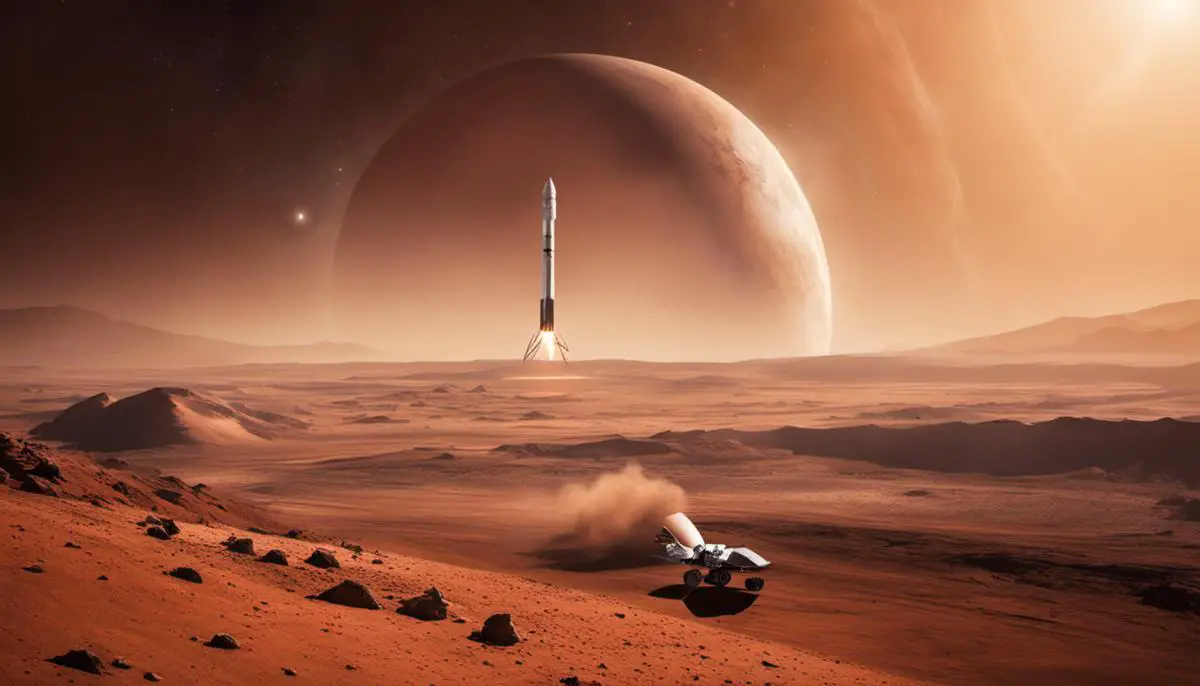
The Mars Timeline: Projected Launches and Missions
Ambitious Mars Plans: SpaceX’s Initial Goals
The goals of SpaceX are nothing short of audacious, with the desire to reach Mars being a fundamental driving force since the very beginning. In fact, Musk has publically expressed his personal aspiration to spend his final days on Mars, preferably not on impact. In 2016, SpaceX laid out some ambitious tentative dates. The first unmanned Mars missions, according to these projections, were aimed to take off as soon as 2022, with crewed missions following shortly in 2024.
Technology Testing: Preparing for the Journey
In preparation for the Mars missions, SpaceX has been rigorously testing their spacecraft, specifically their flagship Starship. The Starship, intended to be a fully reusable spacecraft, has been repeatedly tested with mixed results. While progress has certainly been made, the goal of a flawless Starship flight has not yet been fully realized.
The Starship: SpaceX’s Key to Mars
The Starship is crucial to achieving SpaceX’s Mars goals. It has been designed to carry up to 100 passengers and comes with life-support systems and in-space refilling capabilities. Till now, SpaceX has completed multiple tests on the hop of the spacecraft, a controlled touchdown, and its prototype higher-altitude flights.
First Mars Mission: Deadline Pushed Back
The first touchdown on Mars by an unmanned SpaceX spacecraft was initially projected for 2022. However, the deadline has been pushed back due to complexities surrounding the development and testing of Starship. While a more realistic timeline has not been officially given by SpaceX, experts suggest a delay of several years seems most likely.
Crewed Mars Missions: A Delayed Dream
SpaceX’s first crewed mission to Mars was initially expected to follow shortly after the unmanned missions, targeting a 2024 arrival. However, given the delay in Starship development, this has also shifted.
The Role of Regulatory Approval: Another Variable in Timeline
Another factor that may impact the timeline of SpaceX’s Mars missions is regulatory approval. Before any mission can happen, SpaceX will need approval from institutions such as the Federal Aviation Administration (FAA) in the USA. These processes can often be time consuming, and potential delays could shift the timeline further.
Mars Base Alpha: SpaceX’s Ambitious Outpost
SpaceX CEO Elon Musk has spoken about establishing a permanent base on Mars, termed Mars Base Alpha. The timeline for this is even more speculative, with Musk stating in 2018 that it could potentially be established by 2028.
Daunting Implications: Space Travel is Far from Simple
Space travel is marked by immense complexity and numerous hurdles. Safeguarding the crew and the spacecraft while voyaging across the unpredictable vastness of space multiplies these challenges manifoldly. The trials endured in space have already influenced the SpaceX Mars timeline and will continue to do so.
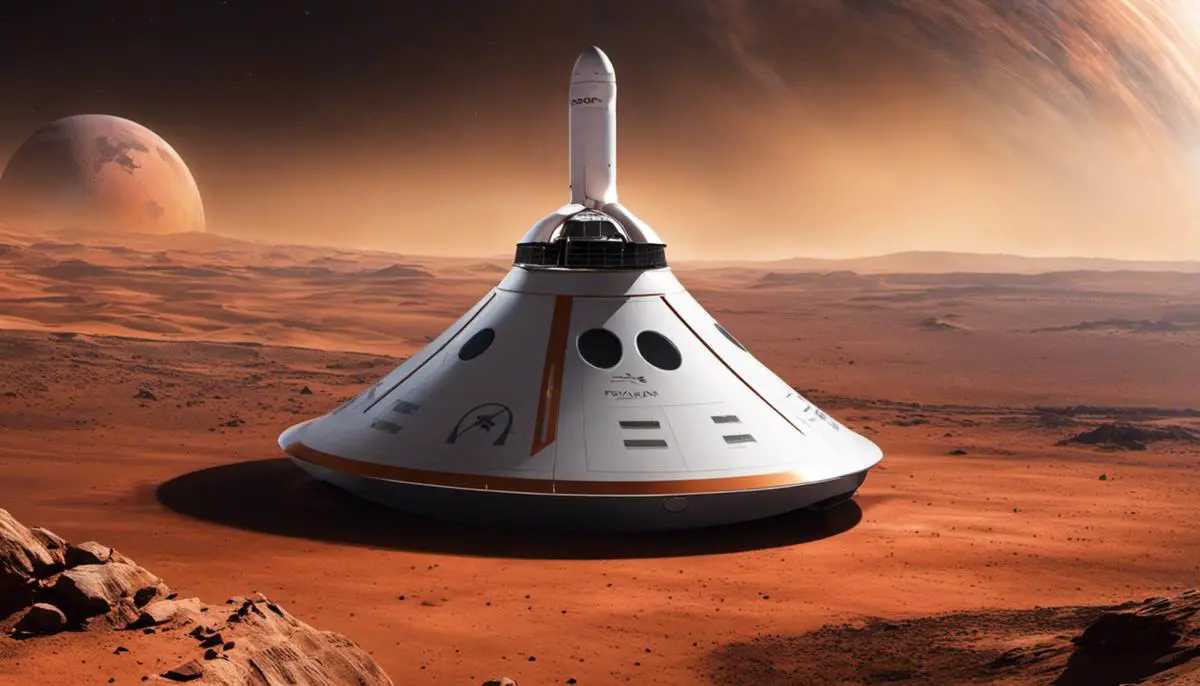
The Challenges and Solutions for Mars Colonization
Obstacles in Mars Settlement: Coping with Intense Challenges
Among the formidable obstacles in the path of Mars colonization, human health and safety stand out. In the severe environment of Mars, humans are exposed to hazards like cosmic radiation, diminished gravity, and long-term isolation. All these factors pose significant health concerns for the Mars mission and are duly accounted for in the SpaceX Mars timeline.
On top of this, the Martian atmosphere, dominated by carbon dioxide, is incredibly thin, making it inhospitable for humans. The scarcity of naturally breathable oxygen, potable water, and nutrient-dense food further exacerbates the challenges faced by SpaceX.
Potential Solutions: Life Support Technologies and Habitat Designs
To overcome these dangers, SpaceX intends to develop state-of-the-art life support systems to ensure the availability of breathable air, potable water, and food supply. These systems would include the development of closed-loop systems for food production, water purification, air replenishment, and waste recycling.
Furthermore, SpaceX is focused on designing habitats that can withstand Mars’ harsh environment. The habitats need to shield inhabitants from harmful radiation and maintain a constant internal environment. These structures will likely incorporate local resources, for instance utilizing Martian soil for radiation shielding.
Resource Extraction on Mars
Another challenge for SpaceX’s Mars plan is ensuring access to necessary resources. The Mars vehicles will depend heavily on Mars’ natural resources for fuel production and other essential functions. The Mars program seeks to use in-situ resource utilization (ISRU) strategies to extract and process these resources.
The plan involves sourcing crucial resources such as water from Martian ice-caps and extracting Carbon Dioxide from the Martian atmosphere. These elements can then be combined to create methane fuel for the SpaceX starship, essentially facilitating a self-sustaining colony.
Psychological Challenges for Long-Term Isolation
The psychological impact of long-term isolation and confinement on Mars is a significant issue that SpaceX is tackling. Mars colonists will not only have to manage prolonged separation from earth but also the constant closeness with a small group of other colonists.
SpaceX’s strategy to address these psychological issues involves comprehensive crew selection and training processes focusing on mental health as much as physical fitness. Plus, considerations will be taken into the design of habitats to include private spaces and community areas to balance the necessity for privacy and socialization.
SpaceX’s Path to Mars: A Timeline
With a close look at the SpaceX Mars timeline, one can see the initial missions are chiefly concerned with sending cargo and creating a foundational infrastructure. This would include elements like energy and life support systems. SpaceX’s plan includes the ambitious objective of sending the first crewed mission to Mars within the timeframe of the mid-2020s.
SpaceX’s ultimate aim is to establish a self-sufficient city on Mars by the year 2050. Despite incredible challenges, the firm remains committed to their vision of enabling a multiplanetary existence, thereby bolstering Earth’s sustainability.
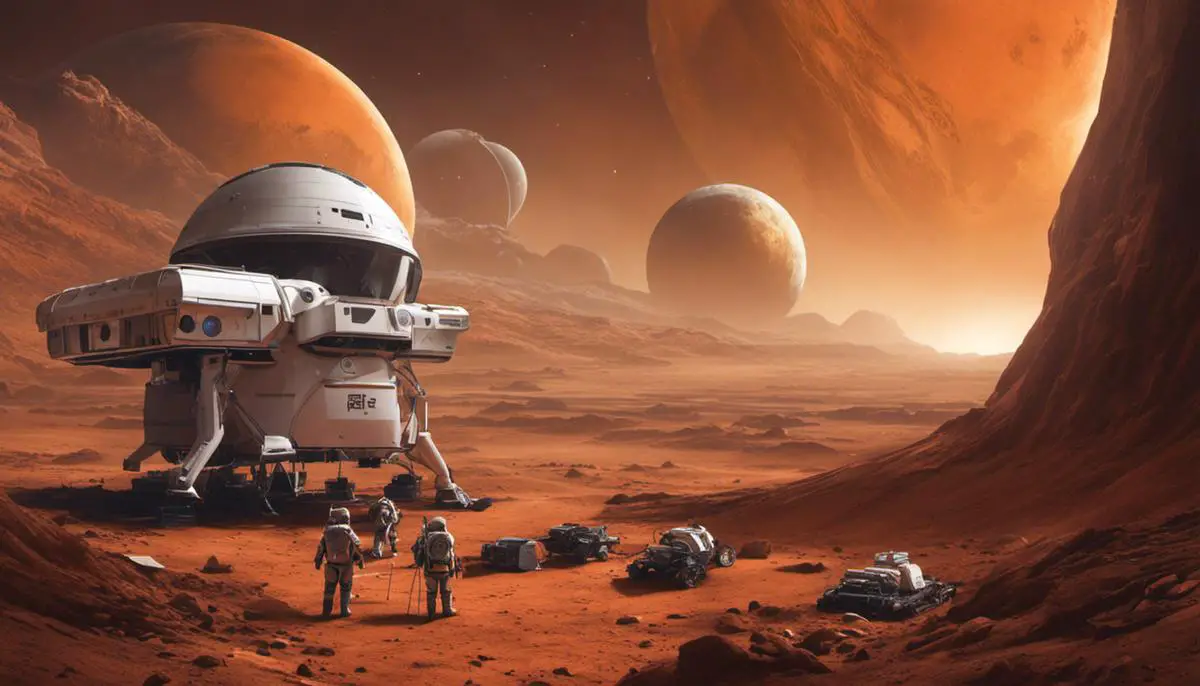
Impact of SpaceX’s Mars Missions on Society and Space Travel
Implications of SpaceX’s Mars Mission
Elon Musk, the driving force behind SpaceX, has set out a well-defined timeline that aims to put humans on Mars as early as the mid-2020s. This courageous move from SpaceX towards space colonization could lead to unprecedented changes in the fabric of human society.
Implications on Space Commerce
SpaceX’s plans could also instigate significant changes in space commerce. As it stands, SpaceX is already selling seats for future space tours, indicating the emergence of space tourism. Furthermore, the concept of Mars colonization might necessitate extensive supply missions, generating new business opportunities for the commercial space industry.
Mining asteroids and other celestial bodies for precious metals and resources could also become a lucrative industry. However, this raises questions about the ownership of these resources, and the rights to exploit them.
Legal Implications of Mars Colonization
The legality of colonizing Mars and exploiting its resources is a gray area. The Outer Space Treaty, ratified by 110 countries, including the United States, prohibits nations from claiming sovereignty over celestial bodies; however, it does not explicitly address the activities of private companies.
In this context, SpaceX’s Mars colonization plan could compel the international community to review and amend existing space laws. This could lead to significant advancements in space legislation, establishing a framework for future extraterrestrial activities.
Cultural Impact of SpaceX’s Mars Mission
SpaceX’s Mars colonization could fundamentally alter human perception of life beyond Earth. The idea that humans could live on another planet could challenge societal norms and paradigms, potentially redefining what it means to be a citizen, or even a human.
The prospect of a multi-planetary human civilization might also reshape educational curricula, with an increased emphasis on space science, making it an integral part of global education systems.
Government Response to SpaceX’s Mars Mission
Governments around the world might be forced to respond to SpaceX’s Mars colonization plan in various ways. Some might react by supporting their national space agencies, leading to an increase in funding for space research and exploration. There could also be significant political competition and tension, mimicking cold-war era space race dynamics.
Overall Impact of SpaceX’s Mars Mission
SpaceX’s Mars mission could be a landmark in human history, affecting society, culture, commerce, law, and government policy. However, the timeline presented by Elon Musk is ambitious, and it remains to be seen how these potential impacts will play out.
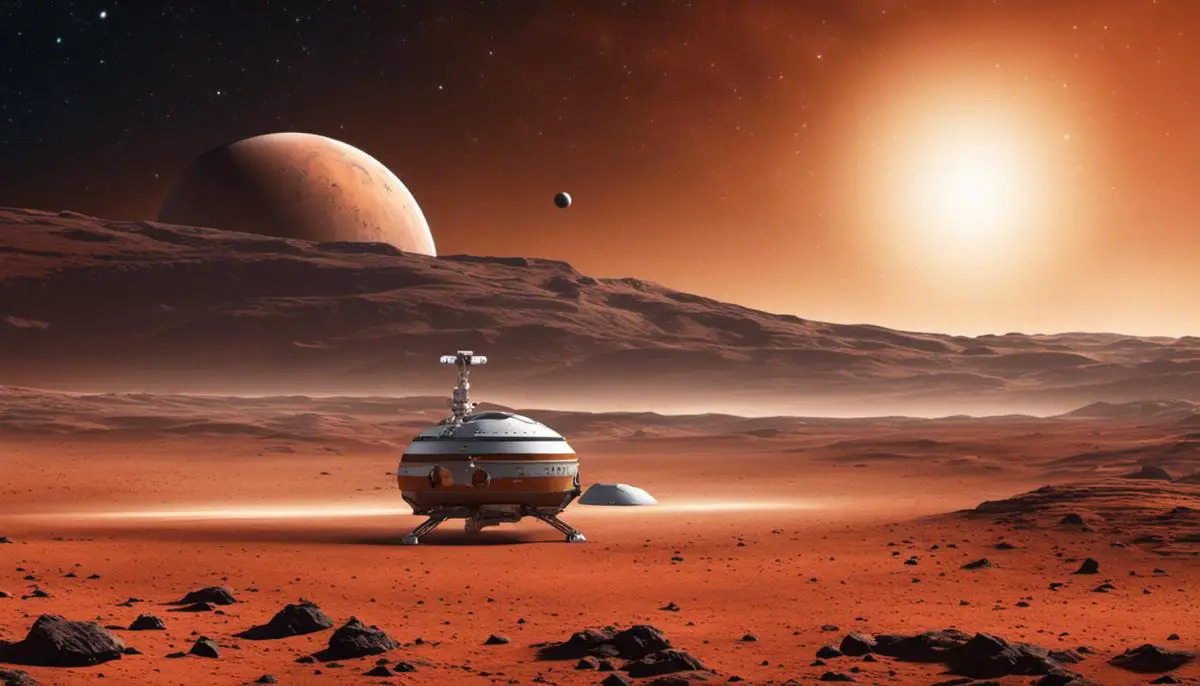
SpaceX’s audacious ambition to colonize Mars is not just an unprecedented quest in human history; it also harbors the potential to reshape how we perceive our existence and our capabilities as a species. The advancements SpaceX is bringing about in space technology, the solutions they are devising to overcome the gargantuan challenges, and their push for a future reality on Mars as a second home for humanity are all testaments of relentless and daring progress. The societal, cultural, and legal implications of this vision are far-reaching and profound. This red planet, a flicker of light in our night sky, may soon be a beacon of human innovation, survival, and our undying urge to explore the unknown.
FAQ
Why did Elon Musk start SpaceX?
With the goal of tackling one of humanity’s most urgent problems—the future of space travel and planet colonization—Elon Musk launched SpaceX, or Space Exploration Technologies Corp. Musk’s conviction that multiplanetary life is necessary for the long-term survival of humanity served as his driving force. He understood the necessity of having a backup plan and was concerned about the possible risks associated with relying too much on a single planet. Musk founded SpaceX mostly due to his unhappiness with the space industry’s sluggish growth and the prohibitively high cost of space travel. By creating reusable rocket technology, bringing down the cost of space travel, and eventually achieving interplanetary travel, his vision was to transform the space industry. Musk’s SpaceX has emerged as a major player in the commercial space sector thanks to its inventiveness and tenacity, pushing the envelope and advancing humanity’s aspiration to colonize several planets.
How did Elon Musk found SpaceX?
SpaceX was co-founded in 2002 by Elon Musk. Musk set out on his quest with the goal of bringing down the cost of space travel and enabling multiplanetary human existence. He put a good deal of his personal wealth into the business, with the original goal of sending a greenhouse to Mars. Following several failed efforts, SpaceX eventually accomplished its first significant milestone in 2008 when the Falcon 1 rocket, the first privately-funded liquid-fueled rocket to reach space, was successfully launched. With contracts with NASA and other agencies secured, this achievement was a game-changer for SpaceX and cleared the path for the creation of the Falcon 9 and Falcon Heavy launch vehicles. SpaceX became one of the most significant participants in the commercial space business today thanks in large part to the foundation and subsequent success of SpaceX, which was greatly influenced by Musk’s innovative attitude, entrepreneurial spirit, and commitment to furthering space technology.
How did Elon Musk start SpaceX and Tesla?
Elon Musk set out to transform two different industries with his ambitious businesses, SpaceX and Tesla. Musk founded SpaceX in 2002 with the intention of enabling multi-planetary life and reducing the cost of space travel. Together with a small group of engineers, he put a large amount of his personal money into creating a ground-breaking private space firm. After achieving significant accomplishments like the Falcon 1 launch, SpaceX emerged as a major force in the commercial space industry.
In contrast, Musk did not start Tesla; instead, he joined and had a revolutionary influence. He became chairman of the board of the electric vehicle startup Tesla Motors (now Tesla, Inc.) in 2004. His financial support and influence were crucial in turning the business into a market leader in electric vehicles and in advancing breakthroughs like the Tesla Roadster and Model S, among other things. After joining Tesla as CEO and chief product designer, Musk led the business toward mass-market electric cars and renewable energy sources.
SpaceX and Tesla are manifestations of Elon Musk’s unwavering quest for innovative technology and his objective to significantly influence the trajectory of space exploration and environmentally friendly transportation in the future. His innovative leadership and entrepreneurial spirit have made a lasting impact on these industries.
How did SpaceX become so successful?
SpaceX stands out in the aerospace business for a number of reasons, which together account for its extraordinary performance. First of all, the corporation had a clear and bold objective thanks to Elon Musk’s persistent tenacity and grandiose ambition to create life multiplanetary. Important factors included Musk’s readiness to contribute a sizeable amount of his personal fortune to SpaceX and his success in luring outstanding engineers and expertise.
SpaceX’s success may be attributed in large part to its innovation-driven approach, which is demonstrated by the creation of the Dragon spacecraft, the Falcon 1, Falcon 9, and Falcon Heavy rockets, all of which were created with reusability in mind. Because of its reusability, launch costs were considerably reduced, upending the industry’s custom of high prices. In order to establish itself as a pioneer in satellite deployment and commercial spaceflight, SpaceX also obtained contracts with NASA.
The company’s capacity to adapt, bounce back from setbacks, and use an iterative development approach have all been crucial to its success. Additionally, SpaceX showed exceptional dependability with a track record of successful launches. In conclusion, SpaceX has become a leader and pioneer in the space exploration sector thanks to a mix of creative leadership, cutting-edge technology, affordable solutions, and clever alliances with public and private organizations.
How has SpaceX changed the world?
By radically transforming the aerospace industry and space exploration in multiple ways, SpaceX has left an enduring impression on the world. Above all, by developing reusable rocket technology, it has dramatically reduced the cost of access to space and increased the viability of space travel from an economic standpoint. This change has rekindled interest in space and created new avenues for business endeavors, satellite deployment, and scientific research.
The lofty goal of making life multi-planetary by SpaceX has inspired a new generation of space enthusiasts, which has altered the long-term vision for humanity. The Crew Dragon spacecraft and the Falcon Heavy rocket successfully launched by SpaceX have reignited hopes for human expeditions to the Moon, Mars, and beyond.
Furthermore, other businesses and governments have been inspired to innovate and make space exploration investments by SpaceX’s cheap pricing and innovative attitude. It has pushed the limits of what was previously believed to be feasible and redefined what is conceivable in space technology, reviving the desire to explore. By doing this, SpaceX has significantly contributed to transforming public perception of space, making it more affordable, approachable, and full of fascinating opportunities for coming generations.
Why is SpaceX important today?
In the modern world, SpaceX is extremely important for a number of strong reasons. First and foremost, it is now a major factor in driving down the cost of space access, which opens up new possibilities for space-related commercial endeavors, satellite deployment, and scientific research. The rapidly expanding space sector has benefited greatly from this affordability and versatility, which have increased its accessibility and viability as a business.
Furthermore, SpaceX’s accomplishments in creating reusable rocket technology have transformed space travel and raised the bar for effectiveness and sustainability. This is especially crucial in a time when environmental issues and climate change are the most pressing global concerns.
SpaceX’s grandiose vision of interplanetary colonization has inspired scientists, engineers, and members of the general public, particularly with its plans for Mars exploration. This vision has brought back humanity’s feeling of wonder and exploration. The company’s achievements fuel a resurgence of interest in technology and space travel, positioning it as a major force in influencing space exploration’s future and expanding the known universe. A time of growing international cooperation and technological progress, SpaceX’s goals and activities speak to the hopes of a more interconnected and exploratory world.
Why is SpaceX famous?
For a number of strong reasons, SpaceX has gained notoriety and respect across the globe. Primarily, the organization has accomplished trailblazing turns in the aerospace sector, chief among them being the creation of reusable rocket technology. Their multi-flight Falcon 9 rocket has significantly lowered the cost of space travel, upending established industry norms. The success and creativity of SpaceX have garnered them recognition on a global scale.
Additionally, SpaceX’s partnership with NASA and the company’s ability to send passengers to the International Space Station using its Crew Dragon spacecraft have marked a significant turning point in space exploration and a resurgence of interest in human spaceflight.
Elon Musk’s audacious plans to colonize Mars and his grand vision of making life multiplanetary have sparked discussions about humankind’s future beyond Earth. These elements, in addition to their ground-breaking accomplishments and audacious objectives, have elevated SpaceX to a household brand that is now associated with the revival of space travel and the seemingly endless potential of the universe.
How does SpaceX help us?
In several aspects, SpaceX has been crucial in assisting humanity. First and foremost, they’ve made space more accessible for a variety of uses by dramatically reducing the cost of space access through their creative rocket reusability. This has made it possible for technological advancement, satellite deployment, and scientific research to proceed more quickly and affordably.
The partnership between SpaceX and NASA has revitalized the human spaceflight program and ensured a dependable and affordable method of sending men to the International Space Station. This partnership not only lessens the financial load on the US government, but it also improves the capacity of the international scientific and technology community to carry out research in the special environment of space.
The goal of interplanetary settlement by SpaceX has also inspired a new generation of scientists, engineers, and innovators and rekindled public interest in space exploration. SpaceX is a key player in expanding human knowledge, promoting technological advancement, and fostering the hope of a future in which humans may reside on other planets by pushing the frontiers of what is feasible in space travel. All things considered, SpaceX’s discoveries and activities have a significant and beneficial influence on space exploration and all of its uses for our planet’s current and future needs.
![]()
